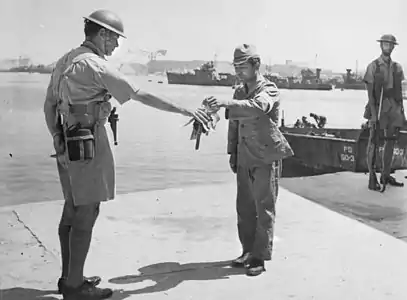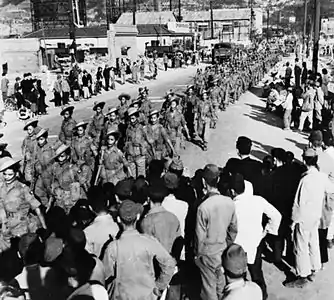British Commonwealth Occupation Force
The British Commonwealth Occupation Force (BCOF) was the British Commonwealth taskforce consisting of Australian, British, Indian and New Zealand military forces in occupied Japan, from 1946 until the end of occupation in 1952.
| British Commonwealth Occupation Force | |
|---|---|
 | |
| Active | February 21, 1946 – 1952 |
| Countries | |
| Allegiance | British Commonwealth |
| Role | Occupation, demilitarisation and disposal of Japan's war industries Operate staging posts for Korean War |
| Size | 40,000 personnel |
| Headquarters | Kure, Hiroshima, Japan |
| Commanders | |
| Notable commanders | Lieutenant General John Northcott (February to June 1946) Lieutenant General Horace Robertson (June 1946 to November 1951) Lieutenant General William Bridgeford (November 1951 to end) |
At its peak, the BCOF committed about 40,000 personnel, that comprised 25% of the occupation force, which was equal to about a third of the number of US military personnel in Japan.
Role
Whilst US forces were responsible for military government, the BCOF was responsible for supervising demilitarisation and the disposal of Japan's war industries.[1] The BCOF was also responsible for the occupation of the western prefectures of Shimane, Yamaguchi, Tottori, Okayama, Hiroshima and Shikoku Island. BCOF headquarters was at Kure, a naval port near Hiroshima.[2]
History
The participation of BCOF in the Allied occupation of Japan was announced on the 31 January 1946, however this announcement was already in planning stages since the end of the war. On the 21 February 1946, the initial contingent arrived.[3] For most of the occupation period Australia contributed the majority of the BCOF's personnel. The initial BCOF presence included the Australian 34th Brigade; the 9th Brigade, 2nd New Zealand Expeditionary Force (J Force); and BRINDIV (sometimes known as BRINJAP), a composite British and Indian division made up of the British 5th Infantry Brigade Group (from 2nd Infantry Division in India), and the 268th Indian Infantry Brigade. BCOF was supported by the Women's Auxiliary Service (Burma) (which derived its name from its formation during the Second World War, to provide amenities to Commonwealth forces in the Burmese campaign).
The position of commanding officer of BCOF was always filled by an Australian: Lieutenant General John Northcott, February to June 1946; Lieutenant General Horace Robertson, June 1946 to November 1951, and Lieutenant General William Bridgeford from November 1951 until the end of the occupation. BRINDIV was commanded by Major General David Cowan, from 1945 to 1947.
The British Pacific Fleet initially provided most of the naval forces, with it consisting of primarily British ships alongside contingents of Commonwealth and US ships. The air component, known as BCAIR, initially comprised the Royal Australian Air Force's No. 81 Fighter Wing, four Spitfire squadrons (including No. 11 and No. 17 of the Royal Air Force and No. 4 of the Indian Air Force), and No. 14 Squadron of the Royal New Zealand Air Force.
During 1947, the BCOF began to wind down its presence in Japan. However, BCOF bases provided staging posts for Commonwealth forces deployed to the Korean War, from 1950 onwards. The BCOF was effectively wound-up in 1951, as control of Commonwealth forces in Japan was transferred to British Commonwealth Forces Korea.
Organisation
The major units that composed the force were
- 34th Australian Infantry Brigade
- 9th New Zealand Infantry Brigade (J Force)
- Brinjap Division[4]
- 5th British Infantry Brigade (renumbered, 25th Independent Infantry Brigade)[5][6]
- 1st Battalion, Queen's Own Cameron Highlanders
- 2nd Battalion, Dorsetshire Regiment
- 2nd Battalion, Royal Welch Fusiliers
- 268th Indian Infantry Brigade
- 5th Battalion, 1st Punjab Regiment
- 2nd Battalion, 5th Royal Gurkha Rifles
- 1st Battalion, Maratha Light Infantry
- 5th British Infantry Brigade (renumbered, 25th Independent Infantry Brigade)[5][6]
Gallery
 30 August 1945. Yokosuka Naval Base, Tokyo Bay. Commander Yuzo Tanno hands over keys of Yokosuka Naval Base to Captain H. J. Buchanan, Royal Australian Navy. Buchanan led the first British Commonwealth party to go ashore in Japan.
30 August 1945. Yokosuka Naval Base, Tokyo Bay. Commander Yuzo Tanno hands over keys of Yokosuka Naval Base to Captain H. J. Buchanan, Royal Australian Navy. Buchanan led the first British Commonwealth party to go ashore in Japan. General Robert L. Eichelberger inspects Australian Guard of Honour at Kure.
General Robert L. Eichelberger inspects Australian Guard of Honour at Kure. Major General David Cowan, General Officer Commanding BRINDIV, inspects Indian troops at Kure, 30 March 1946.
Major General David Cowan, General Officer Commanding BRINDIV, inspects Indian troops at Kure, 30 March 1946. 2nd Battalion, 5th Gurkha Rifles marches through Kure, May 1946.
2nd Battalion, 5th Gurkha Rifles marches through Kure, May 1946.
References
- "British Commonwealth Occupation Force 1945-52". Australian War Memorial. Retrieved 5 December 2020.
- "The British Commonwealth Occupation Force · The Entwistle Collection". Omeka - Western Sydney University. Retrieved 16 July 2020.
- Wood, James. "The Australian Military Contribution to the Occupation of Japan, 1945–1952" (PDF). Australian War Memorial. Retrieved 6 December 2020.
- "Brinjap Division" (PDF). British Military History. Retrieved 8 December 2020.
- "badge, formation, British, 2nd Infantry Division". Imperial War Museums. Retrieved 8 December 2020.
- "badge, formation, 25th Independent Infantry Brigade". Imperial War Museums. Retrieved 8 December 2020.
- Gillespie, Oliver A. The Pacific. The Official History of New Zealand in the Second World War. War History Branch, Department Of Internal Affairs.
Further reading
- Singh, Rajendra (1958). Post-War Occupation Forces: Japan and South-East Asia. Delhi: Combined Inter-Services Historical Section (India & Pakistan) India, Orient Longmans [distributor]. OCLC 518916.
- George Davies, The Occupation of Japan: The Rhetoric and the Reality of Anglo-Australasian relations 1939 – 1952, 2001
- John Dower, Embracing Defeat: Japan in the Wake of World War II, 2000
- Melissa Miles & Robin Gerster, Pacific Exposures: Photograph and the Australia-Japan Relationship, 2018
- Peter Bates, Japan and the British Commonwealth Occupation Force 1946 – 1952, 1993
- Robin Gerster, Travels in Atomic Sunshine: Australia and the Occupation of Japan, 2008
- Takemae Eiji, The Allied Occupation of Japan, 2002
External links
| Wikimedia Commons has media related to British Commonwealth Occupation Force. |